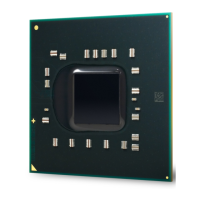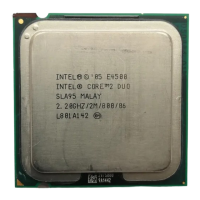Thermal Management Logic and Thermal Monitor Feature
Thermal and Mechanical Design Guidelines 35
PROCHOT# and generate an interrupt whenever there is a transition from active-to-
inactive or inactive-to-active. PROCHOT# can also be configured to generate an
internal interrupt which would initiate an OEM supplied interrupt service routine.
Regardless of the configuration selected, PROCHOT# will always indicate the thermal
status of the processor.
The power reduction mechanism of thermal monitor can also be activated manually
using an “on-demand” mode. Refer to Section
4.2.5 for details on this feature.
4.2.5 On-Demand Mode
For testing purposes, the thermal control circuit may also be activated by setting bits
in the ACPI MSRs. The MSRs may be set based on a particular system event (e.g., an
interrupt generated after a system event), or may be set at any time through the
operating system or custom driver control thus forcing the thermal control circuit on.
This is referred to as “on-demand” mode. Activating the thermal control circuit may
be useful for thermal solution investigations or for performance implication studies.
When using the MSRs to activate the on-demand clock modulation feature, the duty
cycle is configurable in steps of 12.5%, from 12.5% to 87.5%.
For any duty cycle, the maximum time period the clocks are disabled is ~3 μs. This
time period is frequency dependent, and decreases as frequency increases. To
achieve different duty cycles, the length of time that the clocks are disabled remains
constant, and the time period that the clocks are enabled is adjusted to achieve the
desired ratio. For example, if the clock disable period is 3 µs, and a duty cycle of ¼
(25%) is selected, the clock on time would be reduced to approximately 1 μs [on time
(1 μs) ÷ total cycle time (3 + 1) μs = ¼ duty cycle]. Similarly, for a duty cycle of 7/8
(87.5%), the clock on time would be extended to 21 μs [21 ÷ (21 + 3) = 7/8 duty
cycle].
In a high temperature situation, if the thermal control circuit and ACPI MSRs
(automatic and on-demand modes) are used simultaneously, the fixed duty cycle
determined by automatic mode would take precedence.
Note: On-demand mode can not activate the power reduction mechanism of Thermal
Monitor 2
4.2.6 System Considerations
Intel requires the Thermal Monitor and Thermal Control Circuit to be enabled for all
processors. The thermal control circuit is intended to protect against short term
thermal excursions that exceed the capability of a well designed processor thermal
solution. Thermal Monitor should not be relied upon to compensate for a thermal
solution that does not meet the thermal profile up to the thermal design power (TDP).
Each application program has its own unique power profile, although the profile has
some variability due to loop decisions, I/O activity and interrupts. In general,
compute intensive applications with a high cache hit rate dissipate more processor
power than applications that are I/O intensive or have low cache hit rates.
The processor TDP is based on measurements of processor power consumption while
running various high power applications. This data is used to determine those
applications that are interesting from a power perspective. These applications are
then evaluated in a controlled thermal environment to determine their sensitivity to

